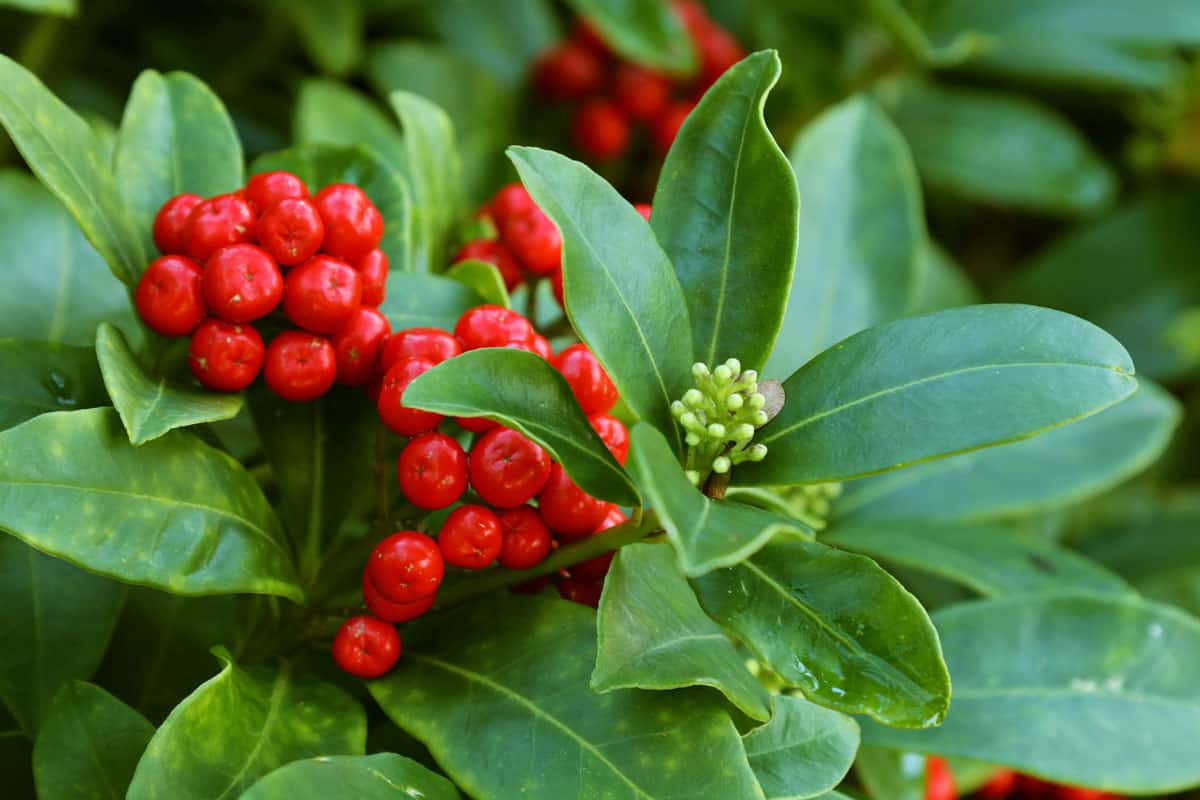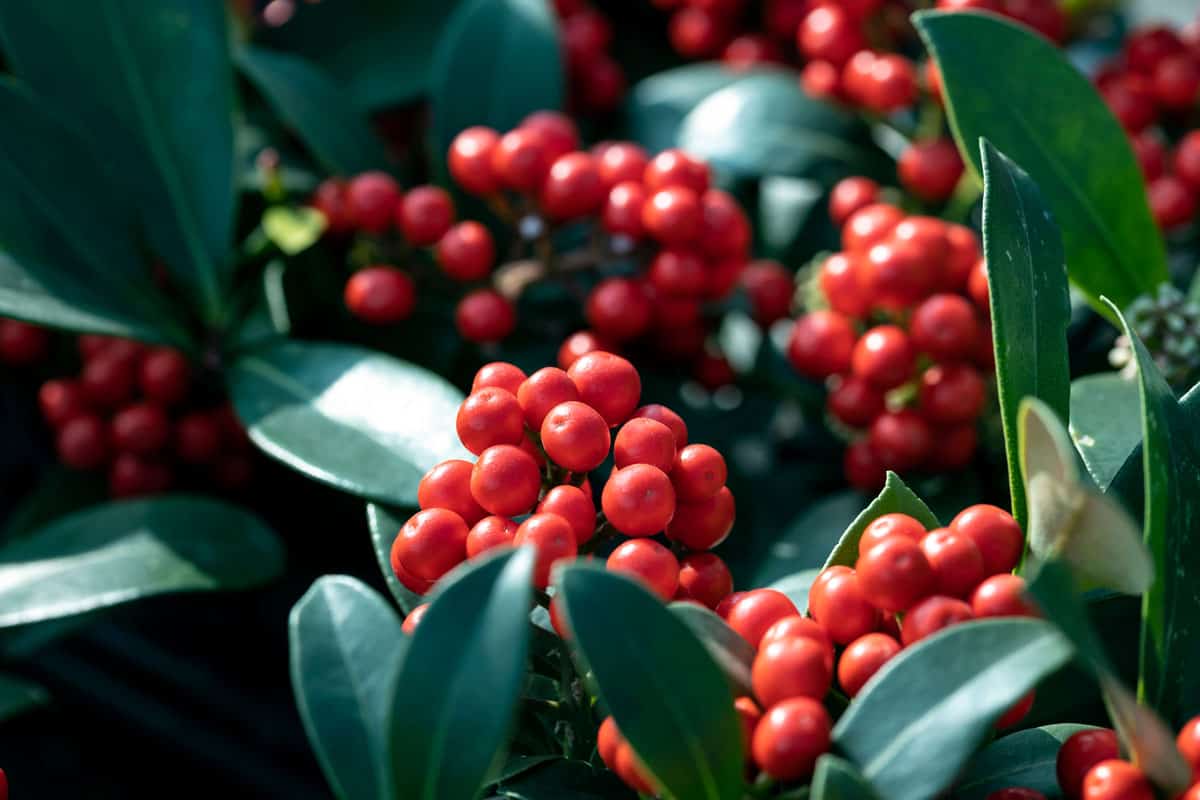It can be a nail-biter to determine whether it's safe to grow a certain plant species in your garden. For example, do you want to try planting a skimmia shrub but don't know whether it's poisonous? Is this Asian-native plant harmful to dogs, cats, birds, or even humans?
Well, we've researched this question extensively and have the answers below!
In general, skimmia shrubs can be incredibly poisonous if ingested in high quantities. Since this species is poisonous, your pets, wild animals, and even people can become very ill after consuming the berries or other sections of this glossy shrub.
Furthermore, many health experts warn that ingesting the berries from skimmia in large volumes can cause cardiac arrest, so doing this can become deadly.
As we begin this article, we will cover all things skimmia bushes and discuss whether they're poisonous. If you recently added skimmia to your garden, want to grow one of these shrubs, or have additional questions, we're here to help. With that said, let's dive right into this topic below!
![bright red skimmia berries have survived, Are Skimmia Berries Poisonous? [Inc. To Dogs, Cat, Birds, Or Humans]](https://gardentabs.com/wp-content/uploads/2022/12/Are-Skimmia-Berries-PoisonousInc.-To-Dogs-Cat-Birds-Or-Humansrev.png)
Are Skimmia Plants Poisonous?
Yes. Skimmia, as a whole species, is poisonous to animals and people. Health experts list this Asian-native shrub as highly poisonous, often causing severe reactions if you consume its berries or foliage.
According to Blessing Landscapes, skimmia is a widely used poisonous plant for gardening, with people often not realizing its toxicity. Furthermore, an interesting fact about skimmia is that the entire plant is poisonous: not just the berries.
Therefore, ingesting high volumes of this plant, whether a person or pet, could cause severe complications. Specifically, eating the berries or foliage from skimmia can often lead to cardiac arrest.
Experts claim that female skimmia is the most toxic, as they produce red berries in winter.
Of course, you shouldn't run into any major health concerns by ingesting a few berries from this plant, but too much can certainly cause death in smaller pets, people, and animals.
If you have a dog, cat, or even a small child, we wouldn't recommend this shrub.
Can You Eat The Berries From A Skimmia Shrub?

No! As we covered above, eating berries from skimmia can cause heart attacks if you consume too many. For example, if your pet gets into the skimmia bush and eats its berries and leaves, it could experience cardiac arrest symptoms.
That's because this shrub is incredibly toxic, often sending the body into shock if over-consumed.
Like many poisonous plants, skimmia comes with many warnings. If you have curious animals that come to your garden often, like birds, planting skimmia could be a death wish for your guests.
Especially for birds and other wildlife, the bright berries on skimmia can trick them into thinking they're safe to eat, ultimately killing them.
So, to avoid these types of complications, it might be better to prevent this species as a whole. Unless you can separate skimmia from the other easy-to-reach plants in your landscape: it could become dangerous.
Is It Safe To Plant Skimmia If You Have Pets?
If you have pets, like a dog or cat, it isn't always recommended to plant poisonous shrubs, trees, and flowers in your yard. Since skimmia is highly toxic to people and pets, having one in your landscape may not be worth the hassle.
You want to factor in what type of pet you have. Is your dog or cat very curious? Has your pet gotten into other outdoor plants before? Will the berries on female skimmia be too tempting for your kitten or pup?
These are all things to consider when shopping for this species. Additionally, many experts recommend against planting poisonous plants, as they can harm wildlife.
As we covered, birds are often targets of skimmia shrubs. If you have bright berries in your garden, a bird is more likely to see them and want a bite.
If the birds eat too many berries from skimmia, they will likely die. The same applies to your fur babies, so to prevent any devastating events from happening, maybe reconsider planting skimmia.
Even if a plant is beautiful to look at, the side effects it comes with can outweigh that.
Will Birds And Wildlife Eat Skimmia?
Depending on how well their senses of poison are, it's possible and common for birds and wildlife to try and consume skimmia berries. Remember, these plants' red fruit can entice hungry creatures.
In general, skimmia isn't very attractive if they're male because they don't produce berries. Therefore, if you have a few male plants in your garden, you shouldn't need to worry about poisoning wildlife.
Interestingly, some creatures will consume small amounts of skimmia without a problem. Again, this Asian plant species is only deadly if eaten in high volumes, so a light snack shouldn't negatively harm birds or other animals roaming through your yard.
Regardless, if you want to err on the side of caution, keeping skimmia out of plain sight could deter birds and other animals from mistaking it for food.
Also, you could try and specifically cultivate male skimmia, as they won't produce berries. You might also notice animals avoid the plant if they get sick from eating it, so word travels fast.
Where Do Skimmia Plants Come From?

If you're unfamiliar with skimmia, this species originates from Japan, China, and Southeast Asia. Since you will typically find most of the skimmia in Asian countries, it isn't always as popular here in the United States.
However, like many foreign plants, skimmia has been imported and planted here for decades. According to North Carolina State, skimmia can even be traced back to Kuril Island, Nansei-Shoto, Primorye, Sakhalin, and Taiwan.
You may also know this species from its technical name, 'Skimmia japonica.' As you can guess, that comes from the fact you often find these ornamental shrubs throughout Japan.
Any time you see the phrase 'japonica' alongside a plant's title that means it's a Japanese species. Japonica is Latin for "of Japan," often a British common name for garden plants of the genus Chaenomeles.
So, even though this shrub comes from Asia, it doesn't mean you can't find it all over the world.
Where Can You Grow Skimmia?
Most times, you want to try to grow skimmia in woodland gardens. Since these ornamental shrubs prefer shade, planting them under large trees and shrubs can be a good idea.
On top of that, skimmia prefer partial to mostly shaded ground conditions, often adapting to full or deep shade if need be. Additionally, skimmia won't be as noticeable to wildlife if you have them covered, which is a win-win.
You may also notice skimmia grows relatively slowly and doesn't require too much upkeep. According to garden pros, you want to avoid planting skimmia in the full sun.
Even though that may be perfect for certain plant species, giving skimmia too much direct contact can be deadly. Specifically, skimmia can burn in high exposure and even die altogether.
Therefore, if you have a few trees in your landscape, that could be the perfect place to cultivate a few skimmia bushes. Remember, the shadier, the better!
Can I Grow Skimmia In Full Shade?
Yes! Skimmia could be the perfect species for you if your garden is mainly shaded. As we said above, this Asian-native shrub handles shade very well and prefers it over total sun exposure.
Many experts refer to skimmia as a shade-loving species, so it will thrive under dense tree canopies. Furthermore, skimmia can do exceptionally well as ground covers, which are perfect for heavily wooded landscapes.
Most times, finding plants for tree-filled yards can be tricky, so that won't be a problem for skimmia. With that said, we recommend ensuring your shrub gets some sun, whether it's dappled through the morning or afternoon.
Too much shade can cause waterlogging and other drainage issues for skimmia, so that's one thing to keep in mind. Again, even a couple hours of indirect light can make a difference.
Is Skimmia Difficult To Grow And Manage?

When it comes to growing and caring for skimmia, this shouldn't be difficult. Besides the fact these plants can grow in heavily shaded conditions, skimmia tends to be very independent.
The main factor you need to worry about for skimmia upkeep is water. This species prefers constant moisture in their soil, although this shouldn't be excessive.
However, since your skimmia will likely be in heavy shade, the water you give it won't evaporate or drain as quickly as it does in full sun. So, you could get away with weekly watering, and that should maintain your plant's soil needs.
It's also worth mentioning that skimmia is a slow-growing evergreen, so you should get to enjoy it throughout the four seasons.
This also makes pruning and caring for your plant easier, as you don't have to stay within a specific timeline. Again, you don't need to do much to keep skimmia happy beside watering it and keeping it out of the full sun.
To Finish

Whether you have skimmia in your landscape or want to grow one, it's always good to know whether a plant is poisonous or not. We found that skimmia, although small, can be very mighty in terms of toxicity.
Specifically, the berries from this ornamental shrub can cause cardiac arrest in animals and humans if eaten in high volumes. Therefore, growing this Asian-native plant may not be good if you have curious dogs, cats, or children.
We also learned skimmia is toxic to birds and wildlife, although they will have a better grasp of how poisonous the plant is. Remember, growing male skimmia is better as they don't produce berries!
Made it to the end? Check out these helpful related articles below:
11 Compact Or Dwarf Flowering Shrubs You Can Plant In A Pot
Are Winter Moths Or Caterpillars Poisonous? [Can You Touch One?]
Are Garden Spiders Poisonous To Humans, Dogs, Or Cats [& Do They Bite]?
